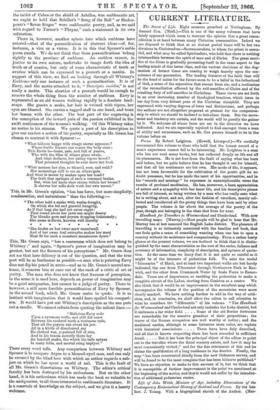CURRENT LITERATURE.
The Secret of L. Eight sermons preached at Nottingham. By
There is, however, another sphere into which emblems have ciliation is at hand between many Christian communities. Indeed we entered—that of the personification of abstract ideas—of, for, are disposed to think that at no distant period there will be but two instance, a vice or a virtue. It is in this that Spenser's noble divisions in Christendom—Sacramentalists, to whom the priest is essen- poem excels. We do not think that these personifications belong tial, and what may be called Spiritualist; who hold that there is nothing rightly to the province of emblems. An emblem cannot, in intermediate between the spirit of man and of Christ. The great sacri- justice to its own nature, uudertake to image forth the idea of lice of the Cross is gradually presenting itself in the same aspect to the truth or of ayarice, but only of some characteristic of truth or leading minds of this latter class, and the various decisions of the Whitney's dog- avarice which can be expressed in a proverb or a maxim.
matism of former times are ceasing to weigh heavily upon the con-
support of this view, we find on looking through all sciences of oar generation. The leading features of the faith that will Enzblemes only one instance of such a personification. It is of be the bond of union for the future seem to be a belief in the fatherhood of God, a sense of the separation that ensues from sin, and a realization Envy, and the motto attached to it, " Descriptio invidite," is not of the reconciliation effected by the self-sacrifice of Christ and of the really a motto. This abortion of a proverb would be enough to resulting duty of self-sacrifice in Christians. These views are set forth remove the whole thing from the number of emblems. Envy is in an ever increasing number of theological treatises, which issue is represented as an old woman walking rapidly in a desolate land- our day from very distant pens of the Christian sheepfold. They are scape. She gnaws a snake, her hair is twined with vipers, her expressed with varying degrees of force and distinctness, and perhaps eyes are bleared. She carries a ragged staff in one hand, and tears the authors are not altogether prepared at present for the companion- her bosom with the other. The best part of the engraving is ship to which we should be inclined to introduce them. But the move- the conception of the inward pain of the passion exhibited in the ment and tendency are certain, and the world will be greatly the gainer






























 Previous page
Previous page